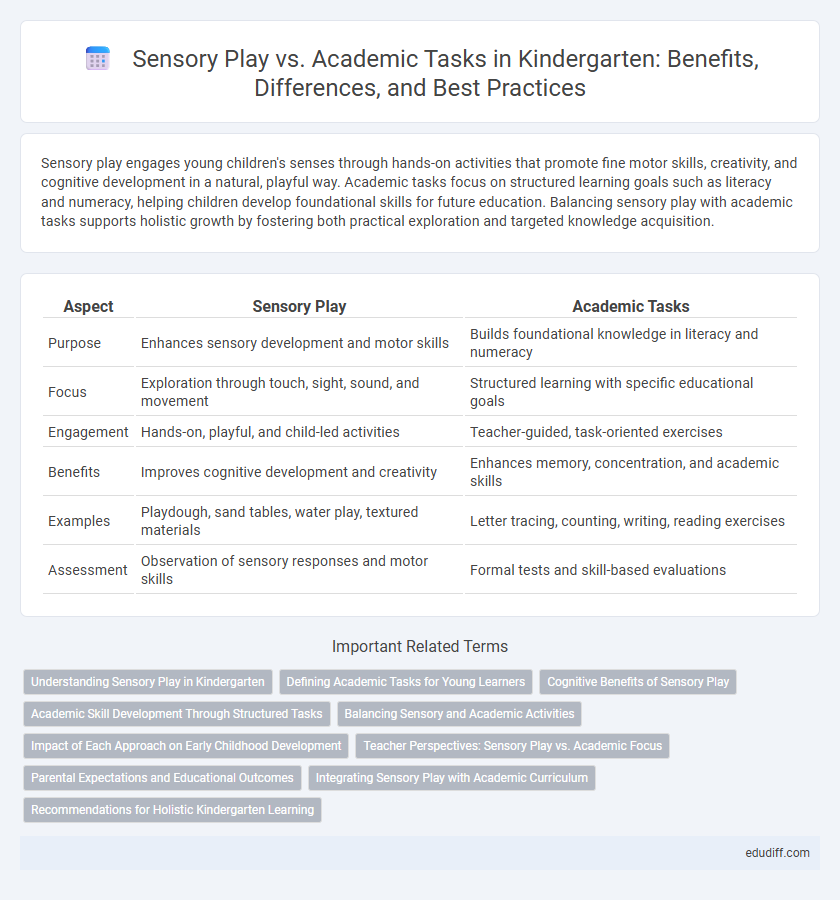Sensory play engages young children's senses through hands-on activities that promote fine motor skills, creativity, and cognitive development in a natural, playful way. Academic tasks focus on structured learning goals such as literacy and numeracy, helping children develop foundational skills for future education. Balancing sensory play with academic tasks supports holistic growth by fostering both practical exploration and targeted knowledge acquisition.
Table of Comparison
| Aspect | Sensory Play | Academic Tasks |
|---|---|---|
| Purpose | Enhances sensory development and motor skills | Builds foundational knowledge in literacy and numeracy |
| Focus | Exploration through touch, sight, sound, and movement | Structured learning with specific educational goals |
| Engagement | Hands-on, playful, and child-led activities | Teacher-guided, task-oriented exercises |
| Benefits | Improves cognitive development and creativity | Enhances memory, concentration, and academic skills |
| Examples | Playdough, sand tables, water play, textured materials | Letter tracing, counting, writing, reading exercises |
| Assessment | Observation of sensory responses and motor skills | Formal tests and skill-based evaluations |
Understanding Sensory Play in Kindergarten
Sensory play in kindergarten engages children through touch, sight, sound, and movement, promoting brain development and fine motor skills more effectively than traditional academic tasks at this stage. Activities like sand exploration, water play, and tactile materials support cognitive growth by enhancing memory, problem-solving, and language abilities. Prioritizing sensory play helps build a strong foundation for later reading, writing, and math skills by fostering curiosity and active learning.
Defining Academic Tasks for Young Learners
Academic tasks for young learners focus on foundational skills such as early literacy, numeracy, and problem-solving activities designed to develop cognitive abilities. These tasks include letter recognition, basic counting, pattern identification, and simple reasoning exercises that build critical thinking. Emphasizing structured learning experiences supports children's readiness for formal schooling while balancing sensory play helps integrate knowledge through hands-on exploration.
Cognitive Benefits of Sensory Play
Sensory play enhances cognitive development by stimulating neural pathways, improving problem-solving skills, memory, and attention span in kindergarten children. Engaging multiple senses through tactile, auditory, and visual experiences fosters creativity and critical thinking far beyond traditional academic tasks. Research shows that sensory activities support brain growth by integrating sensory input with motor responses, essential for early learning and adapting to complex cognitive challenges.
Academic Skill Development Through Structured Tasks
Structured academic tasks in kindergarten foster essential cognitive skills such as literacy, numeracy, and problem-solving by providing targeted learning experiences. These activities promote language development, attention span, and fine motor skills through systematic practice and repetition. Prioritizing academic skill development through structured tasks prepares children for future educational success by building foundational knowledge and discipline.
Balancing Sensory and Academic Activities
Balancing sensory play and academic tasks in kindergarten fosters holistic development by engaging multiple brain areas for cognitive, motor, and emotional growth. Incorporating tactile and kinesthetic activities alongside literacy and math lessons enhances attention, memory retention, and fine motor skills crucial for school readiness. Establishing a routine that alternates between sensory experiences and structured learning promotes optimal engagement and supports diverse learning styles in early childhood education.
Impact of Each Approach on Early Childhood Development
Sensory play fosters cognitive growth by stimulating neural pathways through hands-on experiences involving touch, sound, and movement, enhancing fine motor skills and creativity in early childhood development. Academic tasks promote literacy and numeracy skills by introducing structured learning activities that build foundational knowledge and problem-solving abilities. Balancing sensory play with academic tasks creates a comprehensive developmental environment that supports emotional regulation, social interaction, and early intellectual competence in kindergarten-aged children.
Teacher Perspectives: Sensory Play vs. Academic Focus
Teachers observe that sensory play enhances fine motor skills, creativity, and cognitive development by engaging multiple senses simultaneously. Academic tasks, while essential for literacy and numeracy foundations, often lack the experiential learning and emotional engagement found in sensory activities. Balancing sensory play with structured academic tasks supports holistic development and meets diverse learning needs in kindergarten classrooms.
Parental Expectations and Educational Outcomes
Parental expectations often prioritize academic tasks in kindergarten, believing these activities directly enhance literacy and numeracy skills. However, sensory play significantly supports cognitive development by fostering fine motor skills, creativity, and problem-solving abilities essential for early learning. Educational outcomes improve when sensory experiences complement structured academic tasks, balancing developmental needs and meeting parents' goals for kindergarten readiness.
Integrating Sensory Play with Academic Curriculum
Integrating sensory play with the academic curriculum enhances cognitive development and fine motor skills by engaging multiple senses during learning activities. Incorporating tactile, auditory, and visual stimuli within math, literacy, and science lessons supports memory retention and problem-solving abilities in kindergarten students. Sensory-rich experiences paired with structured academic tasks foster holistic development and increase student motivation and participation.
Recommendations for Holistic Kindergarten Learning
Incorporating sensory play alongside academic tasks fosters holistic learning by enhancing motor skills, cognitive development, and emotional regulation in kindergarten children. Sensory activities such as sand, water, and tactile exploration stimulate neural pathways, complementing literacy and numeracy instruction for balanced skill acquisition. Educators should design curricula integrating hands-on sensory experiences with structured academic goals to support diverse learning styles and promote overall development.
Sensory play vs Academic tasks Infographic

 edudiff.com
edudiff.com